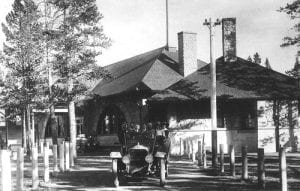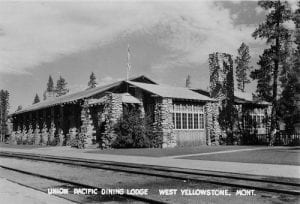With the railroad coming to town, it quickly became apparent to both the railroad and the Town of West Yellowstone that some new buildings and facilities were going to be needed.

View of the railroad district from the water tower.
The Oregon Shoreline began constructing facilities for train operation as well as passenger care at the new terminus. Thanks to the Yellowstone Historic Center I can give you a listing of the facilities that were constructed and the date of their construction. Some of those buildings were either torn down or burned but some are still in use today.
- 1908 A temporary wooden Depot was built
- 1908 The Eating House known as “The Beanery”was built

Union Pacific Railroad Depot
- 1909 The Permanent Depot was constructed
- 1910-15 The Water Tower, Pump House, Freight House, Generator House and Oil House made their appearance
- 1922 The Baggage Building was constructed. (Today this building is the headquarters for the West Yellowstone Police Department.)
- 1922 The Rest Pavilion was constructed.

Union Pacific Dining Lodge
- 1925 The Dining Lodge was built
- 1927 The Men’s Dormitory appeared
- 1927 The Beanery was altered and converted to the Women’s Dormitory
- 1927 The Pump House, Oil House and Generator House were altered by the addition of stone and log cladding

Union Pacific Pylon
- 1927 The Union Pacific Pylon was constructed.
- 1927 Rustic signs were installed
Following the termination rail service to the town, the Union Pacific Railroad deeded the facilities and 10 acres of land to the Town of West Yellowstone. The transfer of property took place in 1966, the same year the town was incorporated. In 1983 the entire 10 acres and those structures that remained were designated as the Oregon Short Line Terminus Historic District and it is listed on the National Register of Historic Places. The town of West Yellowstone owns the historic buildings, while the Museum of the Yellowstone protects, preserves, and shares their history. Photos courtesy of the Museum of Yellowstone. AUTHOR: SUSIE KNAPP